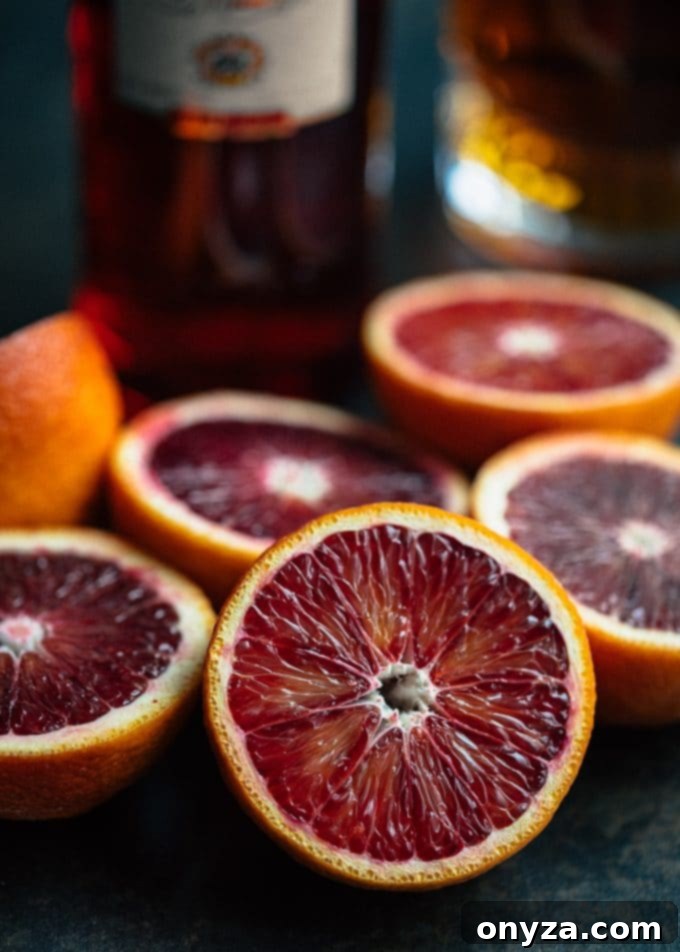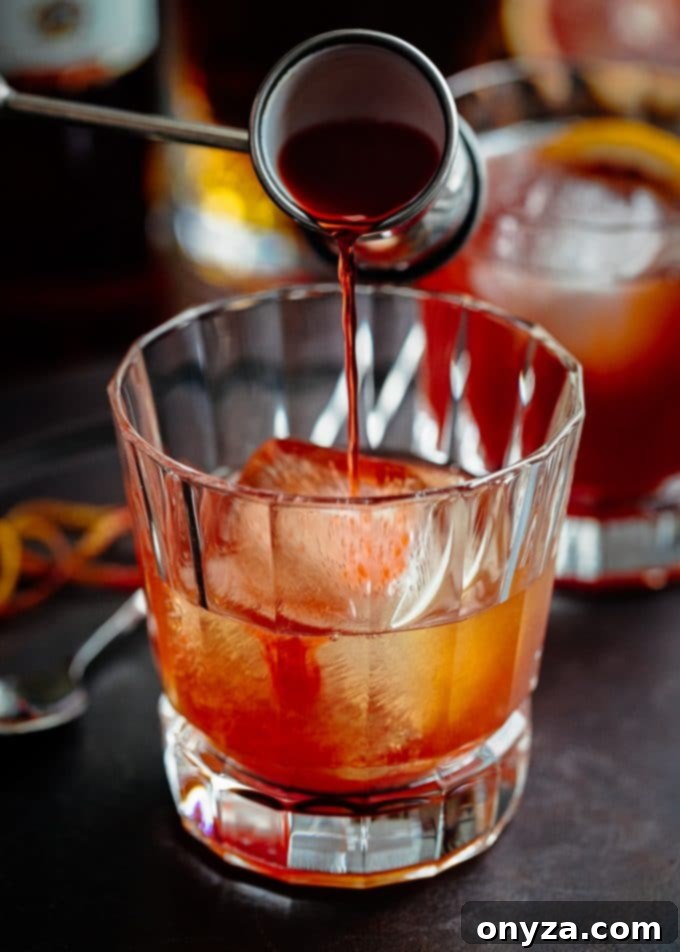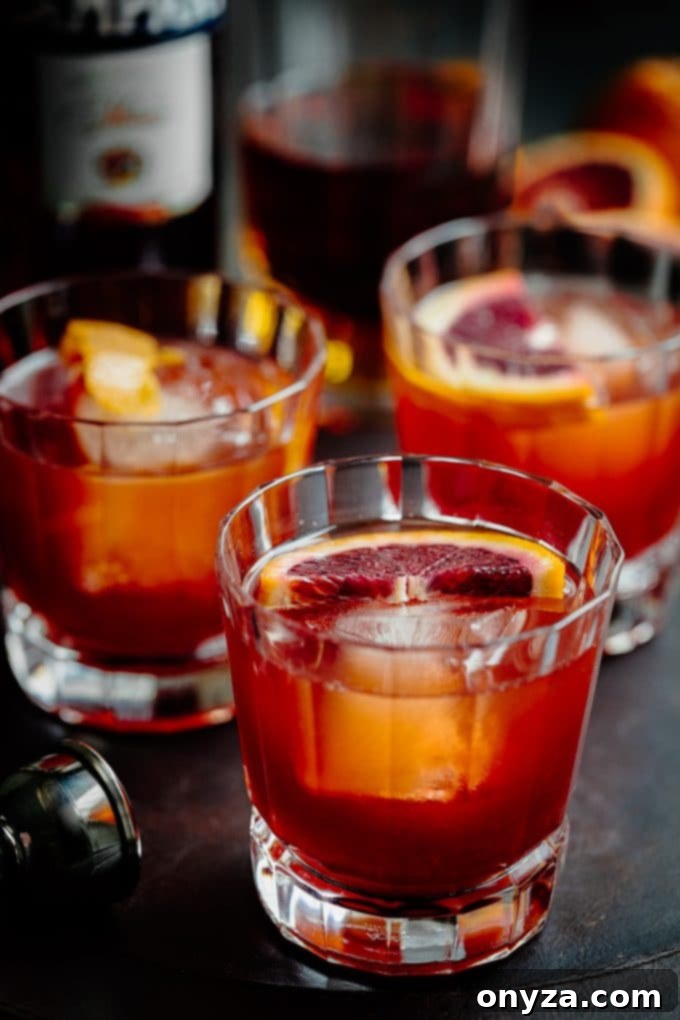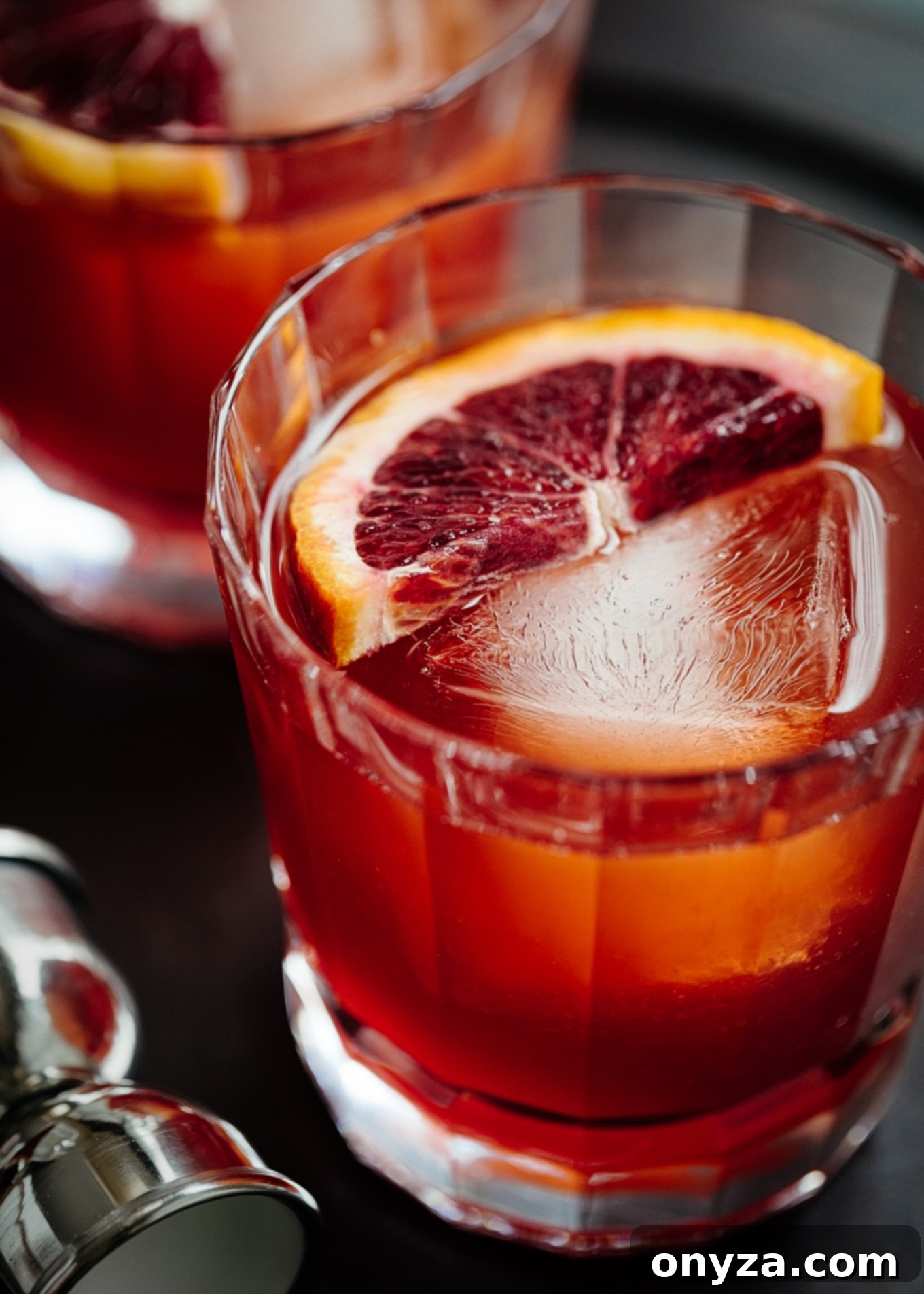The Allure of the Blood Orange Boulevardier: A Sophisticated Winter Cocktail
The Boulevardier, often hailed as the Negroni’s richer, warmer cousin, stands as a testament to sophisticated cocktail crafting. This classic Campari cocktail finds its perfect companion in the vibrant, sweet-tart essence of blood oranges, transforming it into an exquisite sip ideal for cooler days. The Blood Orange Boulevardier is more than just a drink; it’s an experience, a harmonious blend of bitterness, warmth, and citrus that promises to tantalize your palate and elevate any evening.

From Negroni to Boulevardier: A Journey of Taste
My personal journey into the world of Campari-based cocktails, much like for many enthusiasts, began with the iconic Negroni. I recall my first encounter on a balmy summer evening, dining al fresco with a friend. His drink arrived, a striking crimson jewel that immediately captivated my attention. Its alluring, almost devilish red hue was simply gorgeous, a stark contrast to the expected clear or golden cocktails.
Noticing my undisguised fascination, my friend graciously offered a taste. That initial sip was, to be frank, a delightful surprise. I had, perhaps due to childhood memories of overly sweet Shirley Temples, anticipated something syrupy and sugary. Instead, the Negroni—a blend of gin, sweet vermouth, and Campari—presented an assertive yet beautifully balanced profile. It offered a complex interplay of lightly sweet, distinctly bitter, and herbaceous notes. By the second sip, its unique combination felt remarkably refreshing and incredibly sophisticated, setting the stage for a deeper appreciation of bitter liqueurs.
The Negroni Unveiled: Gin vs. Bourbon
The transition from a Negroni to a Boulevardier is a subtle yet significant one, marking a shift in the cocktail’s very soul. While both share the core components of sweet vermouth and Campari, the Negroni’s botanical crispness from gin gives way to the deep, warming embrace of bourbon or rye whiskey in the Boulevardier. This simple substitution elevates the drink, transforming it into what is often affectionately called a “Negroni for the winter” due to its inherently richer and more comforting character.
Gin, with its diverse botanical blend, contributes a dry, aromatic, and often floral or citrusy punch. It creates a vibrant, almost sprightly cocktail perfect for warmer climates. Bourbon or rye, on the other hand, brings a completely different dimension. Bourbon offers notes of vanilla, caramel, oak, and often a subtle spiciness, while rye leans into a bolder, peppery spice. This whiskey foundation lends the Boulevardier a profound depth and a comforting warmth that resonates beautifully as temperatures drop, making it an ideal choice for cozy evenings by the fire.
The Magic of Blood Oranges: Elevating the Classic Boulevardier
In this particular rendition of the classic Boulevardier recipe, we introduce a vibrant splash of blood orange juice, a seasonal gem that elevates the cocktail to new heights. Blood oranges are celebrated not only for their striking, ruby-red flesh but also for their distinctive flavor profile. Unlike conventional oranges, they offer a less acidic, subtly sweeter taste with enticing berry-like undertones, often reminiscent of raspberries or cherries. This unique sweetness and complexity make them an exceptional pairing for the robust notes of bourbon.
The addition of fresh blood orange juice introduces another layer of sweet-tart citrus flavor to the Boulevardier. It brightens the drink, adding a fresh, zesty counterpoint to Campari’s delightful bitterness and the whiskey’s warmth. The result is a Blood Orange Boulevardier that is truly bittersweet, subtly spicy, and undeniably sophisticated. It’s a cocktail that begs to be savored slowly, allowing its intricate flavors to unfold with each thoughtful sip. Moreover, the deep, jewel-toned juice enhances the visual appeal, creating a drink that is as beautiful to behold as it is delicious to drink, perfectly capturing the essence of cooler days and festive gatherings.

A Sip of History: The Boulevardier’s Origins
The classic Boulevardier cocktail (pronounced bool-ah-var-dee-a) possesses a rich history steeped in the romanticism of 1920s Paris. This was an era of unprecedented cultural flourishing, particularly for American expatriates seeking refuge from Prohibition and embracing the vibrant artistic and social scene of the French capital. Among these luminaries was Erskine Gwynne, an American writer and socialite who founded and edited a sophisticated literary and fashion magazine titled “The Boulevardier.”
It is widely believed that the Boulevardier cocktail was crafted specifically for Gwynne, and it quickly became his signature drink. Concocted by Harry MacElhone at Harry’s New York Bar in Paris – a legendary establishment known for inventing many classic cocktails – the Boulevardier perfectly embodied the spirit of the era: elegant, daring, and a touch rebellious. The drink’s name itself pays homage to Gwynne’s magazine and, by extension, to the worldly, stylish individuals who frequented the grand boulevards of Paris. This cocktail, with its deep flavors and intriguing origins, continues to evoke the charm and sophistication of a bygone golden age, offering a tangible link to the literary and social fabric of early 20th-century European high society.
Understanding Campari: The Bitter Heart of the Boulevardier
At the very core of both the Boulevardier and its sibling, the Negroni, lies Campari, the iconic Italian aperitivo with a legacy stretching back to 1860. This vibrant, ruby-red liqueur is not merely an ingredient; it is a flavor powerhouse, made through a secret infusion of various fruits, herbs, and spices with alcohol, simple syrup, and water. Its precise recipe remains a closely guarded secret, contributing to its mystique and inimitable character.
Campari is renowned for its luscious ruby color and, more significantly, its distinctly bitter and herbal flavor profile. For the uninitiated, this bitterness can be quite intense, requiring a palate that is willing to explore and appreciate its complexities. Indeed, the writer William Sertl once famously dubbed Campari “the ultimate acquired taste” in a piece for Saveur magazine. However, once acquired, this unique bitterness becomes incredibly appealing, offering a refreshing counterpoint to sweeter elements and stimulating the appetite, which is why it excels as an aperitivo. Its blend of bitter orange, gentian, and various aromatic barks and herbs creates a sophisticated depth that is unparalleled, making it an indispensable component for cocktails that aim for balance and intrigue rather than simple sweetness.

Crafting Your Perfect Blood Orange Boulevardier: Techniques and Tips
When it comes to preparing your Blood Orange Boulevardier, you have a couple of straightforward mixing options, each influencing the final taste and presentation. The most widely recommended method, particularly for spirit-forward cocktails like this one, involves utilizing a mixing glass. This technique ensures a perfectly chilled and slightly diluted drink, which is crucial for balancing its intense flavors.
Mixing Methods: Stirring for Sophistication
The preferred method involves adding all liquid ingredients—bourbon, sweet vermouth, Campari, and blood orange juice—to a mixing glass generously filled with ice. Stir the mixture diligently until it is thoroughly chilled. This typically takes about 20-30 seconds, allowing the ice to slightly dilute the spirits while bringing down the temperature without aerating the drink. Stirring, as opposed to shaking, is ideal for cocktails composed entirely of spirits and liqueurs, as it maintains their silky texture and clarity. Once perfectly chilled, strain the contents into your chosen serving glass.
Alternatively, you can build the cocktail directly in the serving glass. This method involves pouring each ingredient individually over ice already placed in the glass, then stirring to combine. This approach tends to result in a slightly less diluted drink, which some might prefer for a more potent flavor experience. Whichever method you choose, the key is to ensure the ingredients are well integrated and sufficiently cold. For the built-in-glass method, ensure your blood orange juice is strained to remove any pulp for a smoother consistency.
The Importance of Ice and Dilution
Dilution is an often-overlooked yet critical element in cocktail crafting. It helps to mellow the harsh edges of strong spirits and integrate the various flavors, creating a more harmonious and enjoyable drink. When serving your Blood Orange Boulevardier, especially if you used a mixing glass, you can either pour the cocktail over fresh ice in the serving glass or serve it “up” (without additional ice) in a chilled coupe. My personal preference is to serve it over a single, large square or spherical ice cube. These larger ice forms melt more slowly, providing consistent chilling and minimal dilution, which is perfect for a robust cocktail like the Boulevardier.

The Art of Garnishing: From Simple Twist to Flamed Rind
A thoughtfully chosen garnish is the final flourish that completes any cocktail, enhancing both its visual appeal and aromatic profile. For the Blood Orange Boulevardier, a slice of fresh blood orange or a neatly twisted peel is a natural and elegant choice. The vibrant color of the blood orange complements the drink’s ruby hue, while its essential oils released from the peel add an enticing citrus aroma with every sip. Since blood orange season is fleeting, I seize every opportunity to incorporate them, knowing their unique beauty will soon be gone.
Mastering the Flamed Orange Rind: A Spectacle of Flavor
For those looking to add a touch of theatricality and an extra layer of flavor, flaming an orange rind over your cocktail is an impressive technique. I learned this at a cocktail class years ago, and it never fails to add a certain je ne sais quoi when entertaining. To execute, hold a strip of orange peel (ensure it’s thick enough to get good oil extraction) about two to three inches above the cocktail. Gently warm the rind with a flame (a match or lighter works best) and then, with a quick, firm squeeze, express the citrus oils through the flame and into your drink. You’ll see a brief flash of fire and a subtle mist of aromatic oil settling into the cocktail.
This process not only enhances the drink’s aroma with bright, fresh citrus notes but also imparts a subtle smoky nuance, adding depth and complexity. After flaming, I often run the peel around the rim of the glass to further infuse the experience, then drop it into the cocktail. While it may take a little practice to perfect, the spectacle of flaming a garnish is always a fun and memorable moment for guests, transforming a simple drink into an engaging experience.
Explore More: Related Cocktail Creations
If the Blood Orange Boulevardier has captured your interest, a world of other intriguing Campari and bourbon cocktails awaits your discovery. Each offers a unique spin on classic flavor profiles, showcasing the versatility of these beloved spirits and liqueurs.
Other Campari Cocktails to Discover
- Concord Negroni Flip (The GastroNom): A fruity and creamy twist on the classic Negroni, perfect for those who enjoy a richer texture.
- Negroni Sbagliato (Sidewalk Shoes): Meaning “mistaken Negroni,” this version swaps gin for sparkling wine, creating a lighter, effervescent drink.
- Campari Stinger (Imbibe Magazine): A refreshing yet potent mix that highlights Campari’s herbaceous qualities with a cool mint finish.
- Upgraded Paloma (Serious Eats): While not Campari-centric, this recipe showcases how bitter citrus can elevate other spirits, much like Campari does.
- Blood Peach Bellini (Food & Wine): A delightful, effervescent cocktail that marries the sweetness of peach with the visual appeal of blood orange, offering a lighter option.
Beyond the Boulevardier: Exquisite Bourbon Cocktails
- Blackberry Lemon Mint Juleps (Striped Spatula): A fruity and refreshing take on the traditional Mint Julep, perfect for spring and summer.
- Bourbon Sour with Lavender (Champagne Tastes): An aromatic and floral twist on the classic whiskey sour, offering a soothing and elegant experience.
- Blood and Bourbon (The GastroNom): A direct celebration of bourbon with a blood orange element, emphasizing robust whiskey flavors.
- Spiced Chamomile Ginger Hot Toddy (Meg is Well): A comforting and warming bourbon cocktail, ideal for chilly evenings and soothing the soul.
- The Revolver (Blossom to Stem): A rich and spirit-forward bourbon cocktail with coffee liqueur and orange bitters, similar in complexity to a Boulevardier.
Blood Orange Boulevardier Cocktail Recipe
Bittersweet and spicy, with a hint of citrus, this Blood Orange Boulevardier makes a sophisticated cold-weather sip.
Recipe Details
Prep Time: 5 minutes
Total Time: 5 minutes
Servings: 1 cocktail
Ingredients
- 1-1/2 ounces bourbon (or rye whiskey for a spicier kick)
- 1 ounce sweet vermouth (a good quality brand makes a difference)
- 1 ounce Campari
- 1 ounce fresh blood orange juice (strained to remove pulp)
- Blood orange slices or twisted peels, for garnish
Instructions
- Begin by filling a mixing glass generously with ice. This ensures your cocktail will be perfectly chilled without excessive dilution.
- Add the bourbon (or rye), sweet vermouth, Campari, and the freshly squeezed, strained blood orange juice to the mixing glass.
- Stir the mixture thoroughly for about 20-30 seconds, or until it is well combined and very cold to the touch. The goal is to achieve a beautiful balance of temperature and slight dilution.
- Strain the chilled cocktail into a prepared glass. You can choose a chilled tumbler or a rocks glass over a single large ice cube, or serve it “up” (without ice) in a chilled coupe glass for an elegant presentation.
- Garnish your Blood Orange Boulevardier with a fresh slice of blood orange or a carefully twisted orange peel. For an extra special touch, consider flaming the orange rind before adding it to the drink, as described in the “Mastering the Flamed Orange Rind” section above, to release aromatic oils.
Notes from the Bartender
For a slightly less diluted and more potent cocktail experience, you have the option to build the drink directly in your serving glass. Simply pour each ingredient over ice in the serving glass and stir gently to mix. When using this method, it’s particularly important to strain the pulp from the blood orange juice beforehand to ensure a smooth and refined texture in your final cocktail. Always use fresh ingredients for the best flavor profile.
Nutrition Estimate (Approximate per serving)
- Calories: 209 kcal
- Carbohydrates: 11g
- Potassium: 56mg
- Sugar: 2g
- Vitamin A: 55 IU
- Vitamin C: 14.2mg
Note: Nutrition information is automatically calculated and should be used as an approximation. Actual values may vary based on specific brands and preparation.
